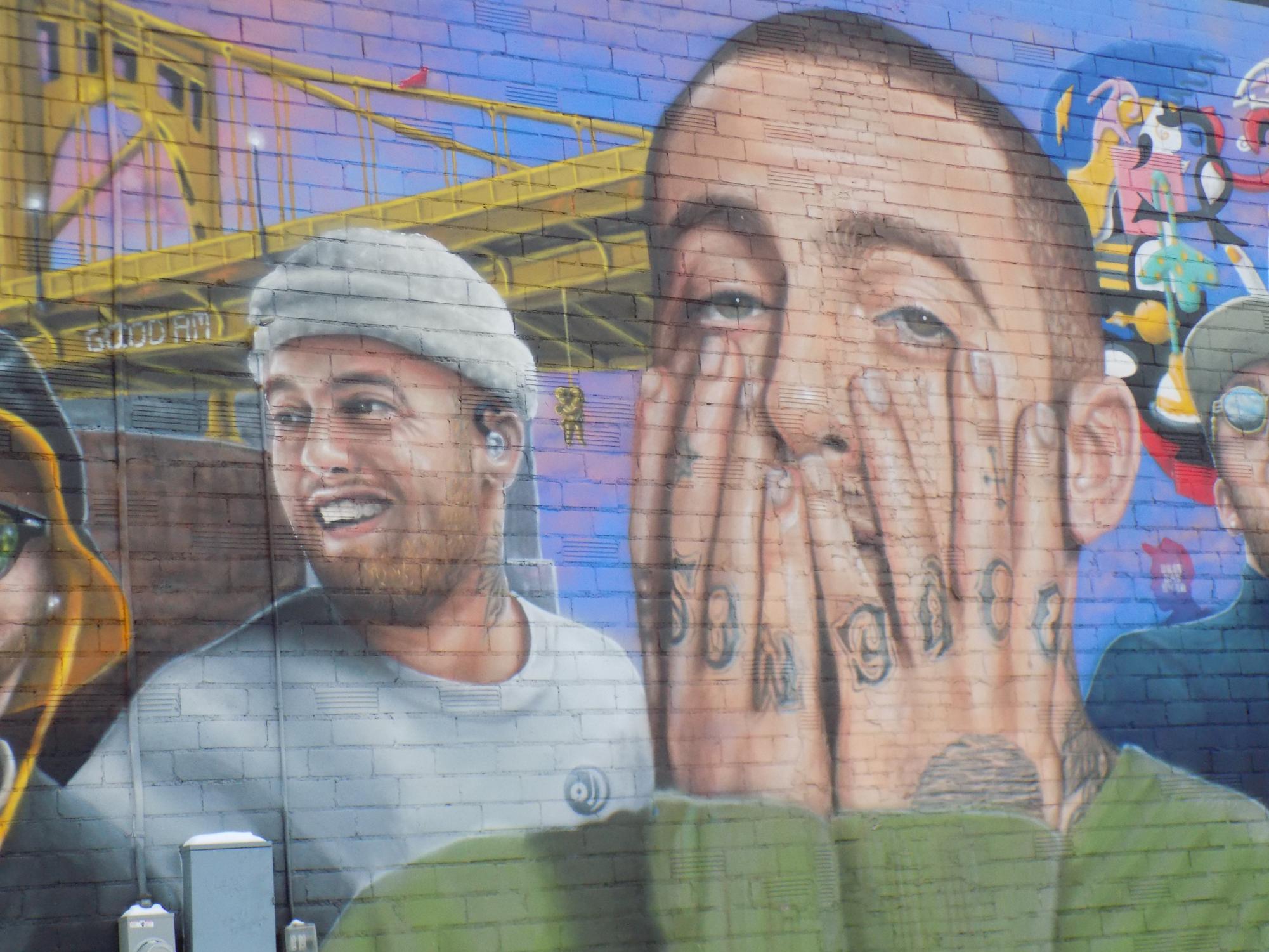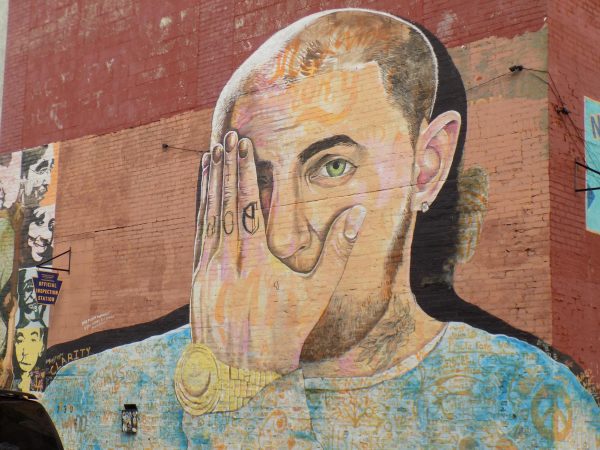The physical legacy keeping Mac Miller’s memory alive in Pittsburgh


Composite Mac Miller mural on Butler street.
The iconic Pittsburgh rapper and musician Mac Miller would have turned 32 today. Miller, whose real name was Malcolm McCormick, grew up in Point Breeze and became one of Pittsburgh’s most prominent cultural exports throughout the 2010s. His music featured ever-present homages to Pittsburgh, from passing ad-libs to songs spotlighting his upbringing.
Though Miller’s death in 2018 brought an abrupt end to his career, physical remnants of his cultural legacy linger around Pittsburgh. These mementos of Miller include public art, graffiti and posters that serve as reminders of Miller’s impact on Pittsburgh — the city that raised him.
Miller’s likeness appears on several public murals around Pittsburgh, many of them created to celebrate his legacy after he died. To mark the one-year anniversary of Miller’s death, the MLK Community Mural Project, a Pittsburgh-based public art group, led the creation of a mural on Paulson Avenue in Larimer, next to another mural that Miller helped paint in 2008. The portrait depicts Miller’s likeness with thousands of miniscule words of admiration and remembrance from the community scribbled onto his shirt.


Kyle Holbrook, executive artist at MLK Mural, knew Miller for almost a decade, beginning when a 16-year-old Miller helped paint murals and record music for MLK Mural after his mother Karen introduced him. Holbrook said MLK Mural was involved in the formative years of Miller’s career, including milestones like his first music video and his first onstage performance. Holbrook said Miller had a larger-than-life personality, even as a teenager.
“He was always cracking jokes, he would start freestyling about everybody … it was just like, he’s not gonna paint, let’s just let him freestyle, because it made everybody happy,” Holbrook said. “I was like, ‘Look at my eyes, man. You’re gonna be a star. You’re gonna make it. Don’t forget that I said that’ … I never knew how much that impacted him until … we were on stage behind the curtain while him and Kendrick [Lamar] was on stage and he told me then, he was like ‘Man, that’s why I went solo.’ He never forgot.”
Holbrook said he wanted to create a living tribute to Miller with the Larimer mural.
“The mural was always intended for people to continually be able to contribute … It’s still going now. Maybe some people went today … and so now if you see the mural, it’s thousands and thousands, it has to be 20,000,” Holbrook said. “It keeps building and growing, all love, people writing messages to Mac, so it’s organic. That’s what I really wanted it to be — living with his energy.”
The last time Holbrook saw Miller was backstage at a Pittsburgh show two years before his death. Holbrook said despite all the fame and fortune, the kid named Malcolm he met in 2008 never really changed.
“Every time I saw him, his big smile, he just straight up never changed who he was — always the same personality, always super humble,” Holbrook said.
ID Labs, a recording studio in Etna, captured Miller’s musical prowess on many tracks throughout his career, along with other Pittsburgh icons like Wiz Khalifa. The studio commissioned a mural from California artist Gustavo Zermaño Jr. on the side of the building honoring Miller’s musical evolution, with seven portraits of Miller at various points in his career superimposed over images from his album covers and a yellow bridge.
Eric “E. Dan” Dan, the producer and engineer who founded ID Labs, said the mural gave them an outlet to immortalize Miller’s impact on the studio and Pittsburgh.
“He has had and continues to have an enormous impact as a person, a musician and a friend,” Dan said. “The mural was a chance to honor his legacy and give his family, friends and fans a physical place to admire his larger than life presence, in both a literal and figurative sense.”
Jeremy Raymer, a Pittsburgh muralist, took to a wall on the North Side to memorialize Miller in 2020. Coinciding with the posthumous release of Miller’s album “Circles,” Raymer designed a wistful portrait of the rapper holding the brim of a baseball cap — Miller often sported a Pittsburgh Pirates hat on stage — and exposing floral tattoos on his neck and wrist. Raymer said the mural came down about two years ago.
“It was only ever meant to be temporary, though — I knew that before I painted it,” Raymer said. “At some point the building was sold and he was cut away. Just a ghost fragment of my name remains.”
Posters advertising Miller’s albums appear on walls around Pittsburgh, largely promoting “Swimming,” his final album before his death. Each poster highlights a particular song on the album, featuring the song title and a cryptic lyric in centered rose-colored lettering. Pittsburghers can also stumble upon posters advertising the 2021 re-release of Miller’s 2014 mixtape “Faces.”
The posters hide in seemingly random locations around the city, often glued to wooden boards or hung on several buildings along Penn Avenue in Bloomfield, an abandoned building on Baum Boulevard, Fifth Avenue in Uptown and an unknowable number of others. It’s unclear who put the posters up — groups like Mac Miller’s estate and the Mac Miller Memoir have promoted his legacy in Pittsburgh and beyond, including annual Celebration of Mac Miller concerts and the Pittsburgh Foundation’s Mac Miller Fund, but neither organization immediately responded to a request for comments on the posters’ origins.
The name of Mac Miller’s 2011 album “Blue Slide Park” alludes to a playground in Squirrel Hill South on the edge of Frick Park, one block from Allderdice High School, which Miller attended. Since his death, the playground has become a sort of Mecca for Miller’s followers, annually flooding with his fans marking the anniversary of his death. In 2019, a user updated Google Maps to rename the playground Blue Slide Park, though the name remains unofficial.
Graffiti around the park commemorates Miller’s music. A park bench near the playground became an ad hoc forum for memorializing messages after fans adorned the bench with quotes and requiems in marker. The bench has since received a fresh coat of paint, along with the eponymous blue slide, but elsewhere in Frick Park a bench bears a plaque displaying a line from Miller’s song “I Can See,” released after his death — “If life is but a dream then so are we.”
Recent Posts
Marquan Pope: The ultimate shark
One of the most remarkable things about sharks is that an injury doesn’t deter them.…
Who Asked? // Do we really get a summer vacation?
This installment of Who Asked? by staff writer Brynn Murawski mourns the seemingly impossible perfect…
Notes From an Average Girl // Notes from my junior year
In this edition of Notes From an Average Girl, senior staff writer Madeline Milchman reflects…
Meaning at the Movies // The Power of the Movie Theater
In this edition of “Meaning at the Movies,” staff writer Lauren Deaton discusses her love…
EMBRACE sponsors Black Maternal Health Wellness week
Because Black women’s maternal health is not institutionally prioritized, Pitt’s EMBRACE sponsored a Black Maternal…
Local ‘Standing Wave’ coffee truck energizes the Pitt food scene
The small business coffee truck “Standing Wave” has become a beloved new coffee spot on…

